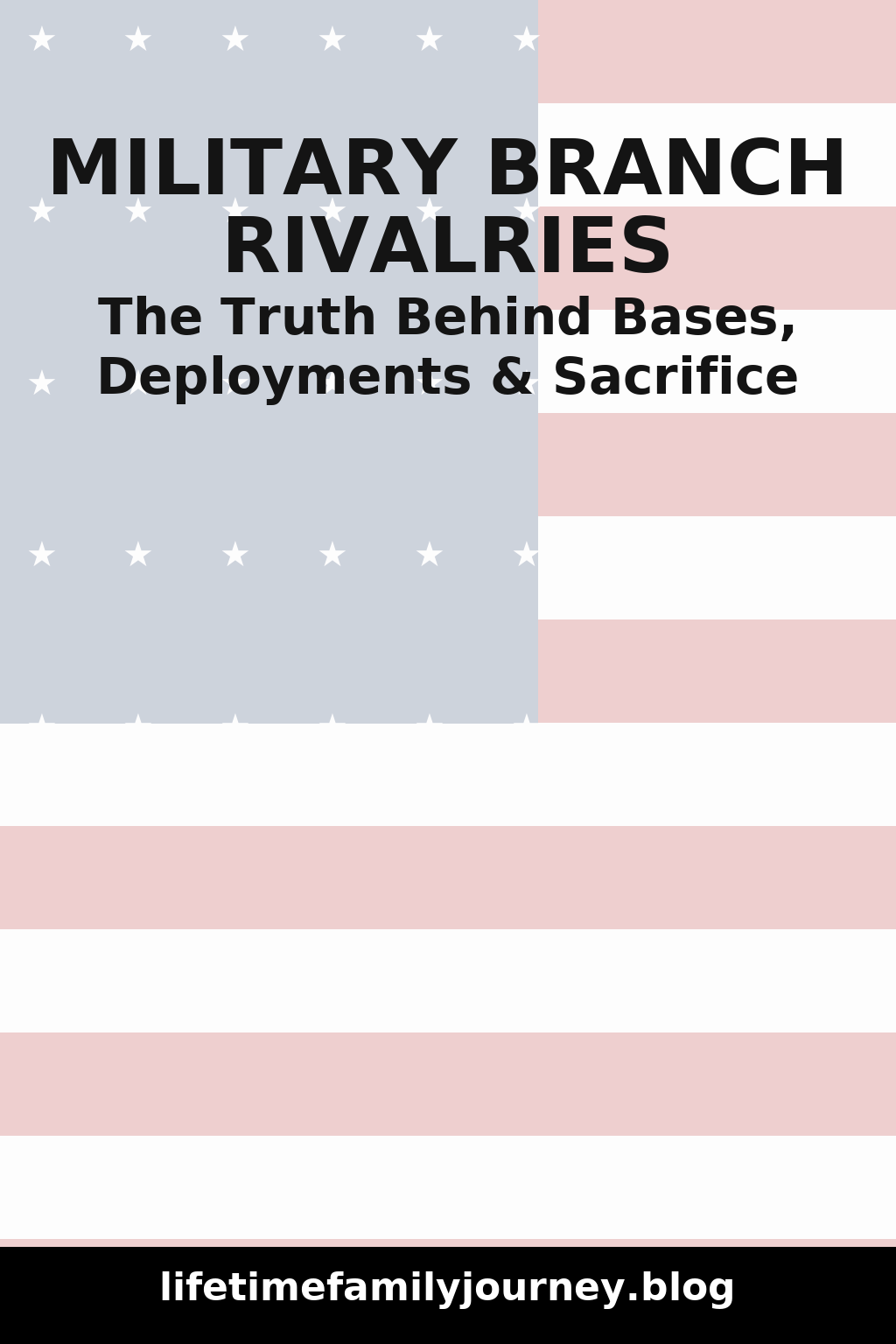Military Branch Rivalries: Harsh Truths Every Veteran Knows
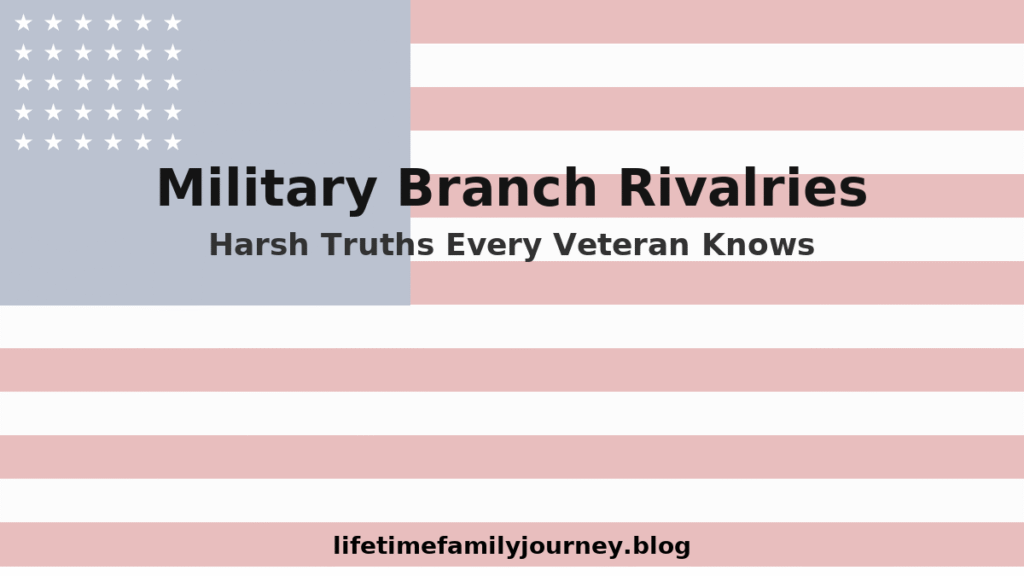
You hear it everywhere—Army grunts calling Air Force members “chair force,” Navy sailors mocking Marines as “crayon eaters,” and everyone questioning what the Space Force actually does. But here’s what numerous years of military service taught me: the jokes are harmless until they’re not.
I deployed multiple times across different theaters, working shoulder-to-shoulder with Soldiers, Sailors, Airmen, Marines, Coast Guardsmen, some of whom are now Guardians, and watched this rivalry play out from barracks banter to toxic entitlement. The truth about military branch rivalries isn’t what you see in memes—it’s messier, more complex, and sometimes uglier than civilians realize.
Before diving deeper, understanding the broader landscape of military service options helps frame why these rivalries develop in the first place.
📋 Quick Reference: Military Terms for Civilians
POG – Person Other than Grunt (non-combat roles)
Dwell Time – Recovery period between deployments
Hot-bunking – Sharing beds/racks due to space constraints
Downrange – Deployed to combat zone
MOS/AFSC – Military job specialty code
CONUS – Continental United States (stateside)
Joint Operations – Multi-branch military missions
🎖️ The Historical Roots Run Deep
Military branch rivalries didn’t start with social media or modern warfare. They began when the Army and Navy were literally fighting over funding, mission relevance, and congressional favor during World War II.
The Army thought they were the backbone—boots on ground, taking territory, winning wars. The Navy believed they controlled the seas and therefore controlled logistics, supply lines, and ultimately victory. When the Air Force split from the Army in 1947, suddenly there were three branches competing for the same budget pie.
Each branch developed its own culture out of necessity. Marines became the rapid-response elite because someone needed to hit beaches first. The Coast Guard handled homeland missions because someone needed to protect our shores. These weren’t arbitrary distinctions—they were born from real operational needs.
According to the Department of Defense, each service branch was established to address specific national security requirements that evolved throughout American history.
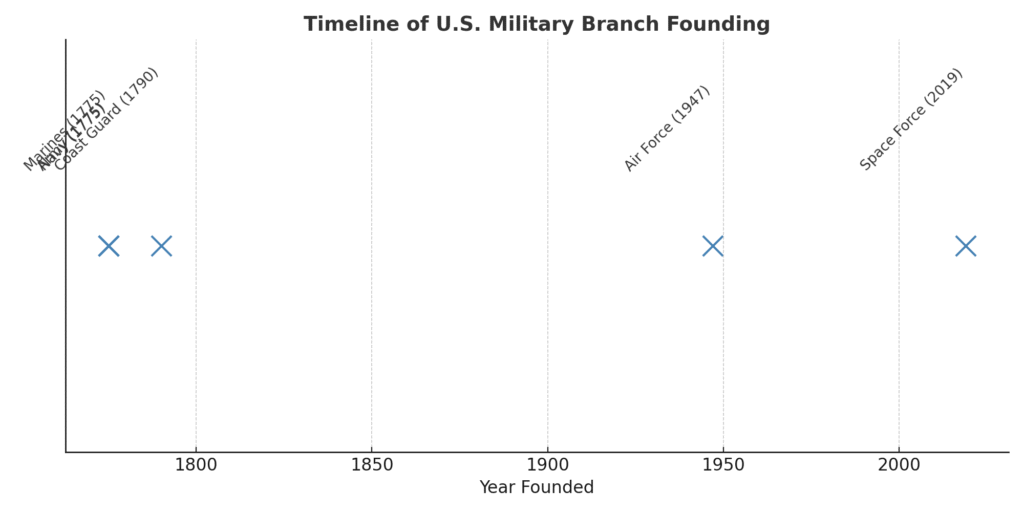
But here’s where it gets complicated: pride in your branch is healthy until it becomes superiority over other branches. I’ve seen sergeants who never deployed mock airmen who’d been downrange six times. I’ve watched sailors fresh from A-school talk trash about soldiers with combat patches.
Understanding the root causes of military branch rivalries helps explain why these tensions persist decades after their original justifications disappeared.
💡 Military Base Quality Differences Between Branches
Let me address the elephant in the room—Air Force bases really are nicer. I’ve been to Ramstein, Kadena, and a dozen others. The barracks are newer, the chow halls have better food, and yes, some have actual golf courses.
Think of it like comparing different corporate offices: Google’s campus has nap pods and gourmet cafeterias, while a construction company’s office has metal desks and a coffee pot. Same purpose, different approaches.
But here’s what the “chair force” jokes miss: those bases support 24/7 global operations that never stop. While I was sleeping in my rack in Iraq, Air Force maintainers were working 12-hour shifts in 120-degree heat keeping aircraft mission-ready. The crew chief who lives in that “resort” base also works nights, weekends, and holidays to ensure jets can support ground troops.
Army bases look different because the mission is different. When your job is training for ground combat, you don’t need a resort—you need firing ranges, training areas, and facilities that can handle the wear and tear of constant field exercises.
Marine bases are spartan by design, not because the Corps hates comfort. When your culture emphasizes toughness and adaptation, your facilities reflect that ethos. It’s like comparing a CrossFit gym to a country club—both serve their members, but with different philosophies.
These base differences fuel military branch rivalries, but they reflect mission requirements rather than favoritism or neglect. To civilians, this might seem like unfair treatment. But here’s why it matters: when these differences become sources of resentment rather than understanding, they affect how smoothly joint operations run.
🚨 Military Deployments Compared: The Reality Behind Service Rivalries
Here’s where military branch rivalries get really toxic—when people start comparing deployments like they’re competing in the Suffering Olympics.
Think of it like different types of demanding jobs: a trauma surgeon works 36-hour shifts but gets weeks off, while an emergency dispatcher works steady 12-hour shifts but handles life-or-death decisions daily. Different stress, same sacrifice.
As an Air Force veteran, I can tell you the “easy deployment” stereotype is complete nonsense. While Army units deploy for 12-15 months and then have dwell time (recovery period at home base), we were constantly rotating in and out of combat zones. Four-month deployments with six-month breaks sounds better on paper until you realize you’re doing it repeatedly—I deployed seven times in eight years.
Army soldiers deal with year-long separations living in tents, eating MREs, and pulling guard duty every night. That’s brutal. But I spent those same years bouncing between different time zones, different climates, different missions, never getting fully settled anywhere. My family planned around my presence like I was a ghost who occasionally showed up.
Navy deployments see sailors spending 6-9 months at sea, sharing racks (beds) in hot-bunking rotations—where three people share two beds because someone’s always working—missing every family milestone. Marines deploy hard and fast—six months of intense operations, then back to prepare for the next one.
Coast Guard deployments often involve life-or-death search and rescue missions where seconds matter. Space Force supports cyber operations and satellite communications that keep all of us connected to home, often working around the clock to maintain global connectivity.
The cruel irony? While I was deployed “only” four months at a time, I missed the same birthdays, anniversaries, and family events as everyone else. My kids didn’t care if Daddy was gone for four months or twelve months—Daddy wasn’t there when they needed him.
When military branch rivalries focus on comparing deployment hardships, they miss the point that all military families make sacrifices regardless of service affiliation. To civilians wondering why this matters: these comparisons affect how veterans support each other and whether military families can build networks across service lines.
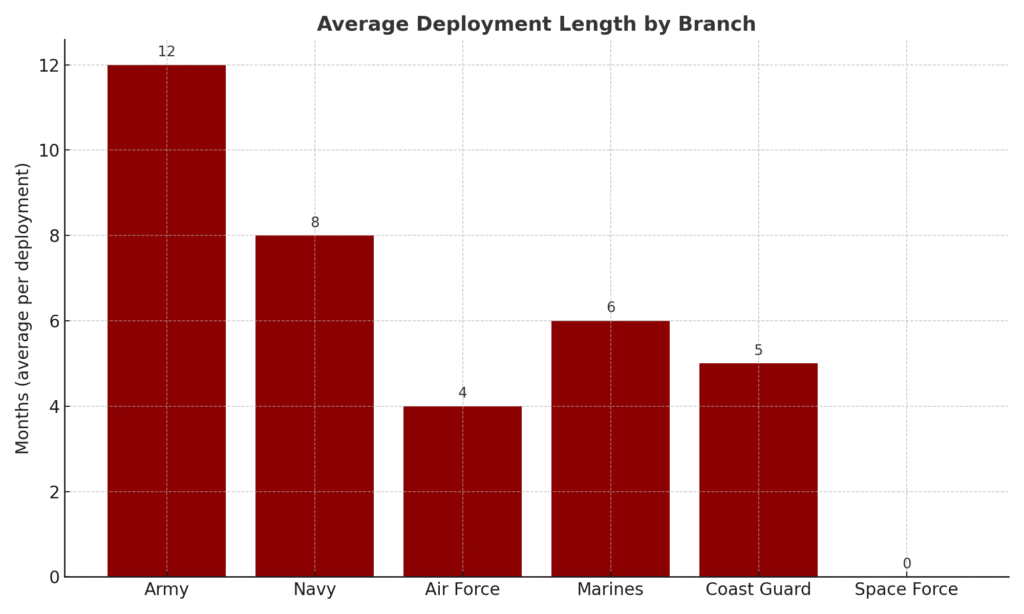
📌 The POG Problem: Understanding Military Identity Attacks
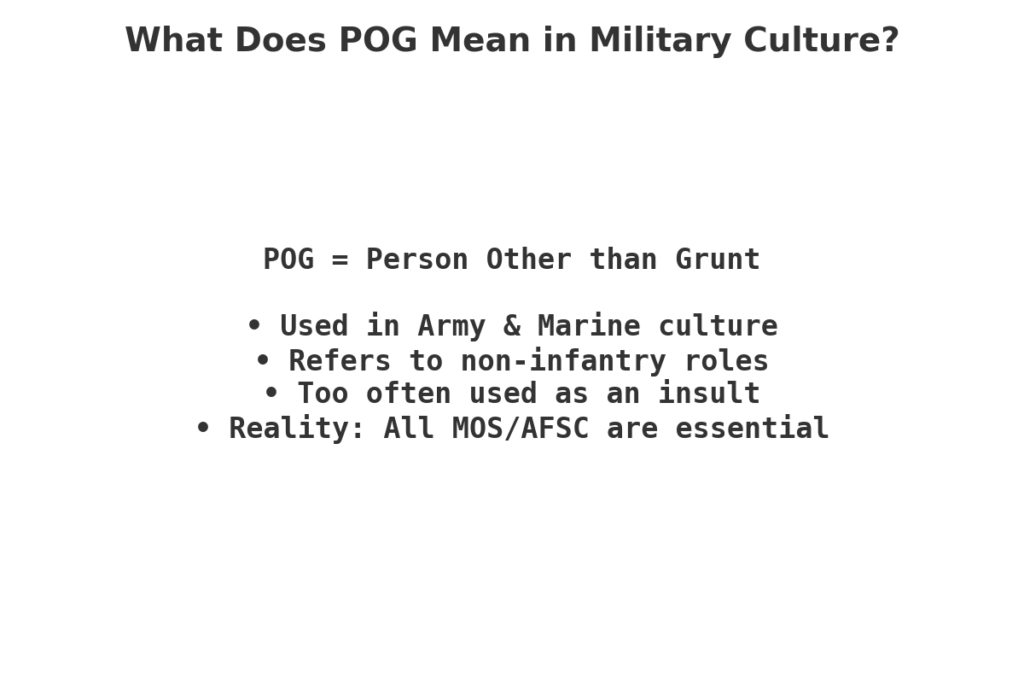
“POG”—Person Other than Grunt—is one of the most divisive terms in military culture. In the Marines and Army especially, it’s used by infantry and combat arms to dismiss anyone who isn’t in a direct combat role.
To civilians, this might seem like harmless name-calling. But imagine if hospital surgeons constantly called nurses, technicians, and administrators “fake medical professionals.” The term carries real venom when it’s thrown around because it attacks someone’s military identity at its core.
Here’s what makes it toxic: POG isn’t just descriptive—it’s deliberately derogatory. When a Marine infantryman calls a motor transport operator a POG, he’s not just identifying their job. He’s implying they’re lesser, softer, and not “real” Marines.
I’ve watched this play out in ugly ways. Cooks getting called POGs while serving hot meals under mortar fire in Iraq. Mechanics dismissed as POGs while fixing broken vehicles on dangerous convoy routes. Air traffic controllers labeled POGs while guiding aircraft through combat airspace.
The brutal irony? Most POGs deploy more frequently than some combat arms troops. That supply specialist you’re mocking has been downrange four times. That admin clerk has convoy experience you don’t have.
This aspect of military branch rivalries extends beyond services to specialties within branches, creating division where unity is essential. Why this matters to outsiders: when military personnel attack each other’s legitimacy, it weakens the professionalism that civilians expect from their armed forces.
🔍 When Rivalries Turn Malicious
Healthy branch rivalry is trash talk that stops when the conversation ends. Malicious rivalry is when service members genuinely believe their branch is superior and other branches are inferior.
I’ve seen it manifest in ugly ways:
- Air Force members refusing to eat at the Army chow hall because it’s “beneath them”
- Army soldiers treating Navy personnel like outsiders during joint operations
- Marines acting like every other branch is soft and undisciplined
- Coast Guard and Space Force members being told they’re not “real military”
This entitlement damages morale, breaks down teamwork, and creates resentment that lasts long after military service ends. When civilians see service members publicly mocking each other, they start questioning whether the military is actually unified or just a collection of competing factions.
The mental health impact is real too. When someone’s military identity gets attacked because of their branch affiliation, it can trigger deeper issues about self-worth, belonging, and purpose. Veterans already face significant challenges with trauma recovery strategies without adding inter-service discrimination to the mix.
Addressing toxic aspects of military branch rivalries requires understanding that healthy competition differs fundamentally from destructive prejudice.
💼 The Civilian Workplace Problem
Military branch rivalries don’t end when you hang up the uniform—they follow veterans into civilian careers. I’ve watched job interviews where Army veterans dismissed Air Force applicants as “soft,” and seen hiring managers confused by veterans arguing about whose service was “more legitimate.”
HR departments rarely understand military culture, so when they witness veterans disparaging each other’s branches, it creates doubt about military professionalism overall. That damages employment prospects for all veterans, regardless of branch.
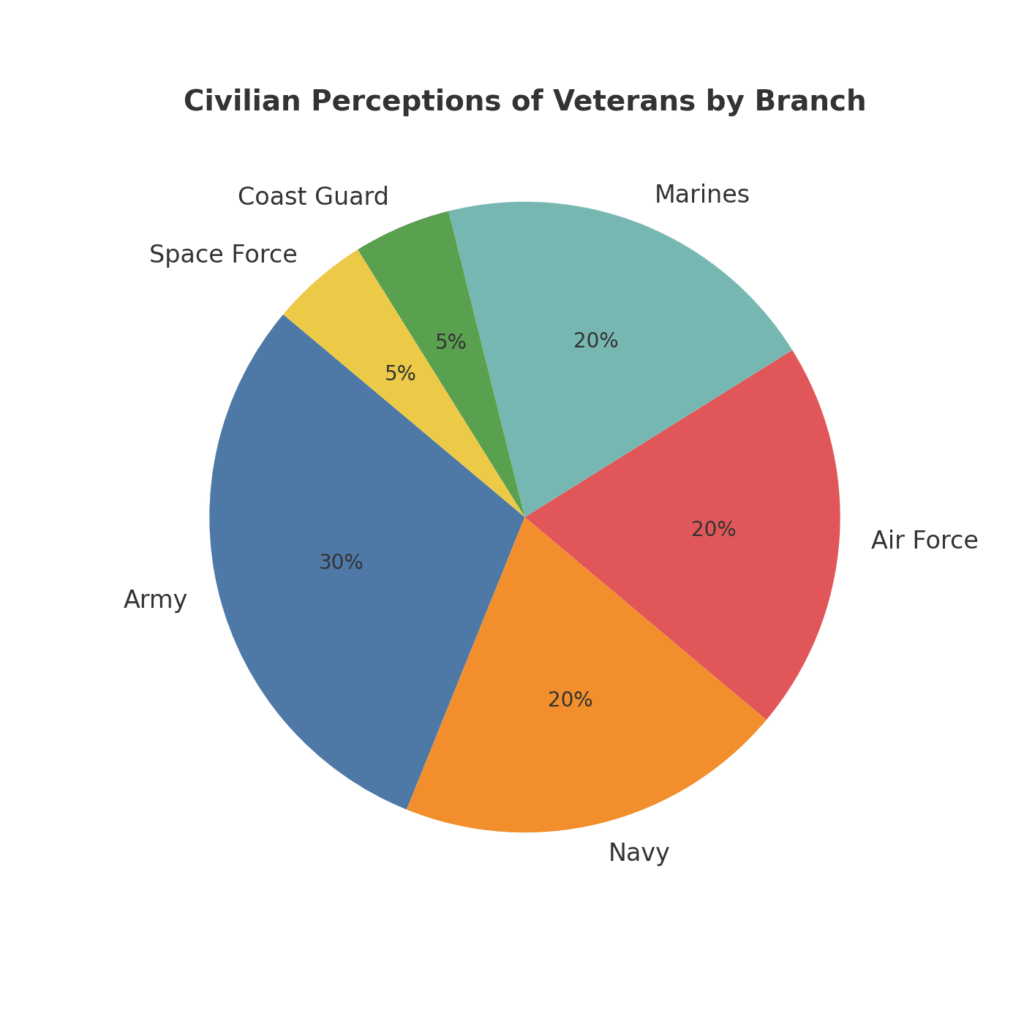
I’ve seen veterans compete against each other for the same positions, with Army infantry trying to minimize Air Force logistics experience, or Navy operations specialists dismissing Marine Corps admin roles. This self-defeating behavior hurts everyone.
The civilian world doesn’t care which branch you served in—they care about your skills, work ethic, and ability to contribute. When veterans waste time arguing about branch superiority instead of highlighting their collective military advantages, they miss opportunities to stand out from non-veteran candidates.
Building better positive mindset habits helps veterans focus on their strengths rather than tearing down other branches’ contributions.
Workplace dynamics often reflect the same military branch rivalries that existed during service, creating unnecessary tension in civilian environments.
💡 The Spouse and Family Factor
Military branch rivalries don’t stay on base—they follow you home. Military spouses inherit these biases whether they want them or not. I’ve watched Army wives refuse to socialize with Air Force families because “they’re not real military.” I’ve seen Navy spouses dismiss Marine Corps families as “too extreme.”
This toxicity spreads to military children too. Kids absorb these attitudes and carry them into school, sports teams, and social situations. When your 10-year-old starts bragging that “Daddy’s branch is better than your daddy’s branch,” you’ve got a serious problem.
Military families move frequently, and this rivalry mentality can isolate them from potential support networks. That Air Force spouse who won’t join the spouse group because it’s “mostly Army wives” is cutting herself off from friendships, childcare help, and emotional support during deployments.
The reality is that military families face identical challenges regardless of branch affiliation—deployments, PCS moves, training schedules, and the constant uncertainty that comes with military life. Branch prejudice adds unnecessary barriers to an already difficult lifestyle.
Family dynamics often mirror the same military branch rivalries that affect service members, creating division where unity would benefit everyone involved.
✅ Cross-Training and Joint Operations
Modern military operations proved that rigid branch boundaries are artificial. During my deployments, I saw:
- Airmen pulling security patrols alongside Army infantry
- Sailors working convoy operations in landlocked Afghanistan
- Soldiers operating from Navy ships during humanitarian missions
- Marines providing close air support for Army ground units
This cross-pollination destroyed stereotypes fast. That Air Force “POG” who’d never fired a rifle in combat was suddenly running patrols and proving he could adapt. That Navy “squid” who’d never been outside a ship was driving trucks through IED-infested routes.
Joint operations became the standard, not the exception. Every significant military victory in the last 30 years required coordination between branches.

Desert Storm, OIF, OEF, humanitarian missions—they all succeeded because different branches brought different capabilities to accomplish shared objectives.
The National Guard and Reserve components also play crucial roles in these joint operations, often bridging the gaps between active-duty branches during domestic and overseas missions.
Cross-training experiences often reduce military branch rivalries by forcing service members to work together toward common goals rather than compete for recognition.
💪 Historical Joint Victories
D-Day wasn’t an Army operation or a Navy operation—it was a joint force masterpiece.
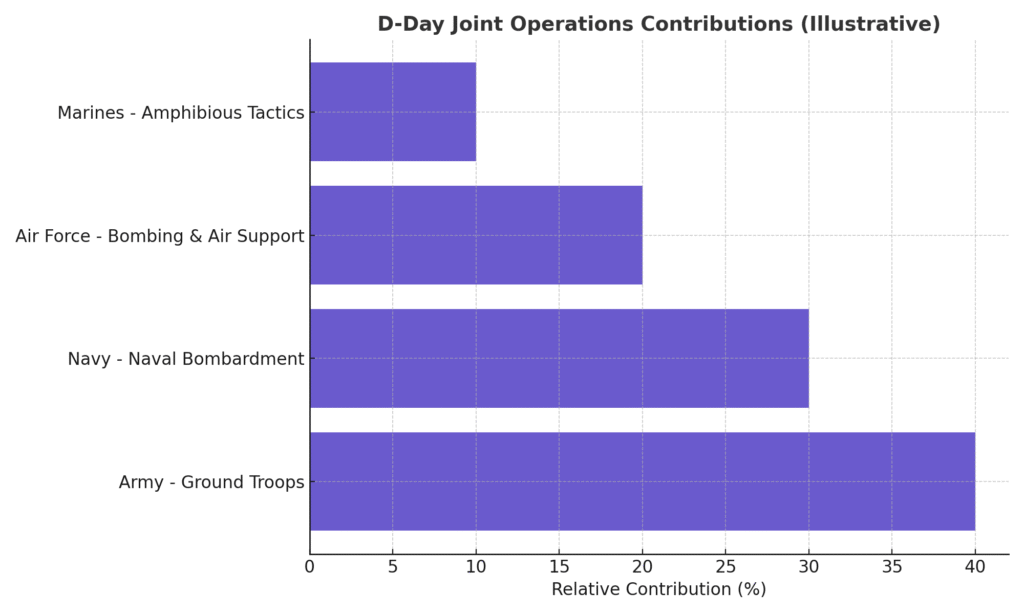
The Navy controlled the seas, the Army hit the beaches, the Air Force provided support, and the combined effort changed history.
Desert Storm showcased modern joint operations perfectly. Air Force and Navy pilots established air superiority. Army and Marine ground forces advanced with coordinated support. The victory belonged to all branches because the mission required all branches.
More recently, the raid that killed Osama bin Laden involved Navy SEALs, Army aviation, Air Force intelligence, and CIA coordination. One branch couldn’t have accomplished that mission alone—but together, they made it look easy.
These examples prove that military branch rivalries become irrelevant when lives are on the line and missions matter. The flag on your uniform is more important than the patch.
Research from the RAND Corporation consistently shows that joint operations increase mission success rates while reducing casualties across all service branches.
Historical analysis reveals that successful military operations minimize military branch rivalries in favor of mission-focused collaboration.
🧠 Reality Check for Civilians
When civilians see military members mocking each other online, they often assume it reflects real dysfunction. Most don’t understand that the majority of inter-service ribbing is good-natured and builds camaraderie.
But when that ribbing crosses into genuine disrespect, it damages public perception of military professionalism. Civilians shouldn’t have to witness service members tearing each other down in public forums.
The sacrifice behind every uniform is real, regardless of branch. That Air Force mechanic working night shifts to keep aircraft mission-ready is serving his country. That Navy cook feeding 5,000 sailors on a deployment is serving his country. That Army medic treating wounded soldiers is serving his country.
Branch doesn’t determine the level of sacrifice—mission and circumstances do.
💔 When Veterans Eat Their Own
I recently saw a Marine post on social media telling other veterans with PTSD to “suck it up.” Another veteran posted “Happy Veterans Day to all except Air Force.” What exactly is this accomplishing?
Absolutely nothing positive. Here’s what it actually does:
It tells struggling veterans they’re alone. When someone with PTSD sees a fellow veteran dismissing their trauma, it reinforces the shame and isolation they already feel. That Marine telling people to “suck it up” just became part of the problem that drives veterans to suicide.
It tells civilians we’re fractured and unprofessional. When non-veterans see us publicly excluding entire branches from Veterans Day recognition, they start questioning whether military service creates unity or division. We look petty, immature, and tribal.
It perpetuates the myth that some service is more valuable than others. That “Happy Veterans Day except Air Force” post ignores every Air Force veteran who:
- Flew combat missions over Iraq and Afghanistan
- Maintained aircraft in 130-degree heat for 12-hour shifts
- Provided close air support that saved ground troops’ lives
- Came home with invisible wounds just like everyone else
This isn’t banter anymore—this is veterans publicly diminishing other veterans’ service and sacrifice. It’s toxic, it’s destructive, and it accomplishes nothing except making us all look bad.
Every veteran raised their right hand and took the same oath. Every veteran left family behind during deployments. Every veteran risked their life in service to this country. Branch doesn’t determine the validity of that sacrifice.
Social media has unfortunately amplified the worst aspects of military branch rivalries, turning private jokes into public embarrassments.
⚡ The Embellishment Problem
Here’s an uncomfortable truth that needs addressing: there’s a toxic subset of veterans who exaggerate their war stories for attention, benefits, or social status. This damages the credibility of legitimate claims and perpetuates harmful stereotypes about military service.
The statistics tell a sobering story. Roughly 40% of those who join the military never get deployed to a combat zone at all, and 10% to 20% of those who do find themselves on a deployment wind up in a combat zone according to Midwest Disability research. Yet somehow, every veteran bar conversation features multiple “door kickers” and combat heroes.
The reality of modern warfare is more complex than Hollywood portrayals. According to data from the Military Times Honor the Fallen database, of the 5,413 US soldiers killed on operation, where the cause of death was known, some 2,640 were killed by IEDs. This means that 48.7% of total military deaths between September 2011 and October 2020 were attributed to IEDs. In Afghanistan specifically, there have been 829 US military personnel killed in Afghanistan by IEDs – some 42% of all American forces killed there during the war according to Action on Armed Violence research.
This matters because it creates false hierarchies within the veteran community. When someone fabricates combat experience they never had, it diminishes the actual sacrifices made by those who did serve in harm’s way. It also perpetuates the myth that only “trigger pullers” experienced real danger or made meaningful contributions.
The truck driver who ran supply convoys through IED-infested routes faced mortal danger every day. The mechanic who kept vehicles running on forward operating bases worked under the same incoming mortar fire as infantry. The cook who served meals at remote outposts dealt with the same isolation, stress, and uncertainty as combat arms troops.
Exaggerating military experience doesn’t honor service—it cheapens it. When veterans lie about their deployments, combat experience, or injuries, they create distrust that affects all veterans seeking legitimate support and recognition.
🎓 Educational Benefits and Healthcare Reality
Here’s where military branch rivalries become particularly absurd: every veteran gets the same GI Bill benefits regardless of which branch they served in. That Air Force mechanic and that Army infantryman receive identical education funding—36 months of tuition coverage, housing allowance, and book stipends.
The VA healthcare system doesn’t have separate facilities for different branches. When you’re sitting in a VA waiting room getting treatment for PTSD or a service-connected injury, nobody asks whether you wore Army green or Navy blue. Your Purple Heart doesn’t specify which branch earned it.
Yet I’ve seen veterans argue about whose military education is “more legitimate” or whose service-connected disabilities are “more deserving.” This mentality is toxic and counterproductive. The GI Bill exists because military service—regardless of branch—involves sacrifice that civilian careers don’t require.
Different branches may offer varying paths to education during service, but the end result is the same: veterans who used their time in uniform to develop skills and earn credentials. Whether you got your degree through Air Force education programs or Army credentialing assistance, you earned it through military service.
Educational and healthcare benefits demonstrate that military branch rivalries have no place in post-service support systems designed to honor all veterans equally.
❤️ Why Mutual Respect Matters
I’ve stood at military funerals where the honor guard included members from different branches. Nobody asked which branch the fallen service member belonged to—they honored the person who wore the uniform.
I’ve been in combat situations where the person next to me wore a different patch than mine. In those moments, we weren’t Army, Navy, Air Force, Marines, Coast Guard, or Space Force—we were Americans serving together.
The brotherhood and sisterhood of military service transcends branch affiliation. We don’t salute branch names—we salute the flag that represents all of us.
When veterans struggle with PTSD, depression, or readjustment issues, their branch doesn’t matter. When families deal with deployment stress, separation anxiety, or military lifestyle challenges, their service member’s patch is irrelevant.
The problems we face as military families are universal, and the support we need comes from understanding that shared experience. Whether you’re navigating VA disability processes or accessing military education benefits, your branch affiliation is less important than your veteran status.
🎯 The Modern Military Landscape
Today’s military operates in domains that didn’t exist 20 years ago. Cyber warfare, space operations, drone technology, and information warfare require specialized skills that cross traditional branch boundaries.
Space Force handles satellite communications that all branches depend on. Coast Guard manages port security that protects Navy installations. Air Force provides cyber capabilities that support Army intelligence operations.
The differences between military branches are becoming more about specialized capabilities than competing cultures. Each branch brings unique strengths to joint operations—strengths that complement rather than compete.
🌍 Regional and International Perspectives
Military branch rivalries aren’t just an American phenomenon, but we’ve amplified them in ways other countries avoid. In regions with major military installations, local civilians often develop preferences for certain branches based on economic impact and community involvement.
I’ve lived near Army posts where the local economy revolves around Fort Bragg or Fort Hood, and the community naturally supports Army culture. Conversely, areas near Navy ports or Air Force bases develop different military identities. This geographic influence can intensify rivalries when service members from different branches are stationed in “hostile” territory.
International military partnerships provide interesting contrasts. During NATO operations, I’ve worked alongside British, Canadian, Australian, and German forces who maintain service distinctions without the toxic superiority complexes. They compete in sports and training exercises, but the rivalry rarely devolves into questioning each other’s legitimacy or worth.
The Reserve and National Guard components add another layer of complexity. Active duty members sometimes dismiss Guard and Reserve as “weekend warriors,” while Guard units pride themselves on balancing civilian careers with military service. These distinctions cross branch lines—an Army Guard unit might have more in common with an Air Force Reserve squadron than with active duty Army infantry.
Regional differences also affect how veterans are perceived post-service. In military-heavy areas like Virginia Beach or Colorado Springs, veteran status matters more than branch affiliation. In civilian-dominated regions, all veterans get lumped together regardless of their service branch.
Geographic and cultural factors significantly influence how military branch rivalries manifest in different communities across the United States.
🔄 Generational Changes in Military Culture
Today’s young veterans approach military branch rivalries differently than previous generations. Social media has both intensified and diminished the toxicity depending on how it’s used.
Veterans who served post-9/11 experienced joint operations as the standard, not the exception. They’re more likely to have worked alongside multiple branches during deployments and less likely to dismiss other services entirely. This generation understands that modern warfare requires integrated capabilities.
However, social media also amplifies the worst aspects of branch rivalry. Memes mocking other branches spread faster than ever, and platforms like TikTok and Instagram create echo chambers where toxic attitudes get reinforced rather than challenged.
Younger veterans also bring different expectations about workplace collaboration and team dynamics. They’re less tolerant of artificial hierarchies based on branch affiliation and more focused on mission accomplishment regardless of uniform color.
The challenge is ensuring that improved joint operations experience translates into better post-military relationships. When young veterans carry positive inter-service experiences into civilian careers, they model better behavior for older veterans stuck in outdated rivalry patterns.
This generation also benefits from better family communication strategies that help military families discuss service differences without creating division.
Understanding how generational differences affect military branch rivalries helps predict future trends in veteran relationships and military culture evolution.
🏥 Medical and VA Healthcare Realities
Branch rivalries become particularly senseless when veterans face medical challenges. The VA healthcare system treats all veterans equally—your service-connected disability rating doesn’t depend on which branch you served in.
I’ve sat in VA waiting rooms where Army veterans with PTSD received the same treatment protocols as Navy veterans with traumatic brain injuries. The medical professionals don’t care about your branch patch—they care about your symptoms, your pain level, and your treatment response.
Different branches may experience different injury patterns based on their missions. Navy personnel might have more hearing loss from engine room exposure. Air Force maintainers might have respiratory issues from aircraft chemicals. Army and Marine infantry might have more orthopedic injuries from carrying heavy loads. But these are occupational differences, not indicators of whose service was “more legitimate.”
Mental health stigma varies somewhat between branches, with some services historically being more accepting of seeking psychological help than others. But when veterans need treatment, branch identity becomes irrelevant—trauma is trauma, regardless of whether it came from IED explosions, aircraft accidents, or sexual assault.
The VA’s mission is to serve all veterans based on their service-connected needs, not their branch affiliation. Veterans who spend energy arguing about whose injuries are “more deserving” are missing the point entirely.
Combat-related PTSD looks the same whether you served on a Navy ship, an Army forward operating base, or an Air Force installation in a combat zone. The families dealing with these invisible wounds need support, not judgment about which branch their veteran served in.
That military mindset about home safety that veterans bring to protecting their families comes from military training regardless of branch—it’s about the mentality, not the uniform color.
Healthcare challenges demonstrate that military branch rivalries become meaningless when facing the universal struggles of injury, illness, and recovery.
🏃♂️ Building Better Team Mentality
Instead of asking “Which branch is best?” we should ask “How do branches work together most effectively?” The answer involves recognizing that different missions require different approaches.
Ground combat requires the Army’s expertise in sustained land operations. Maritime security requires the Navy’s understanding of sea-based logistics. Rapid deployment requires the Marines’ expeditionary capabilities. Homeland security requires the Coast Guard’s law enforcement authority. Air and space superiority require specialized knowledge that Air Force and Space Force provide.
When each branch focuses on their core competencies while supporting others’ missions, the whole force becomes stronger.
The Veterans Affairs recognizes this unity by providing identical benefits to all veterans regardless of which branch they served in, because service to country transcends branch boundaries.
💪 The Leadership Challenge
Military leaders at every level face a choice: perpetuate military branch rivalries or build joint understanding. The leaders I respected most chose the latter.
Effective military leadership means checking your ego at the door when working with other branches. It means acknowledging that your way isn’t the only way. It means recognizing that other services might have better solutions to problems you’ve been solving the same way for decades.
I’ve seen Marine officers learn logistics techniques from Army supply sergeants. I’ve watched Navy chiefs teach maintenance procedures to Air Force technicians. I’ve witnessed Coast Guard petty officers share law enforcement tactics with MPs from multiple branches.
These exchanges happen when leaders create environments where learning trumps pride. When the focus shifts from “proving superiority” to “improving capability,” everyone benefits.
⚡ Mission-First Mentality vs. Branch Pride
The fundamental tension in military branch rivalries comes down to this: mission accomplishment versus tribal identity. Every branch teaches “mission first,” but human nature creates in-group loyalty that can work against joint success.
Successful military leaders learn to balance branch pride with mission requirements. They understand that loving your branch doesn’t require hating other branches. They recognize that unit cohesion within your service can coexist with respect for other services.
I’ve served under commanders who exemplified this balance—proud Marines who praised Army tactics, Navy officers who learned from Air Force procedures, soldiers who acknowledged Coast Guard expertise without feeling diminished.
The best military leaders use branch differences as learning opportunities rather than competition fuel. They ask “What can we learn from how they do this?” instead of “Why do they do it wrong?”
📌 Final Word: One Team, One Fight
Military branch rivalries will never disappear completely—and maybe they shouldn’t. Healthy competition drives innovation, builds esprit de corps, and creates pride in military service.
Think of it like sibling rivalry: brothers and sisters tease each other relentlessly, but when outsiders attack the family, they stand together. Military branches should work the same way—internal competition that strengthens external unity.
But when that rivalry becomes genuine animosity, it hurts everyone. When service members start believing their branch is inherently superior to others, they damage the unity that makes our military effective.
I’ve served alongside heroes from every branch. Some wore Army patches, some wore Navy anchors, some wore Air Force wings, some wore Marine eagles, some wore Coast Guard shields. What made them heroes wasn’t their branch affiliation—it was their commitment to mission accomplishment and taking care of their people.
The flag we all serve under is bigger than the patches we wear on our shoulders. At the end of the day, we’re all Americans who raised our right hands and swore to defend the Constitution. That oath doesn’t specify which branch takes precedence—it applies to all of us equally.
When one branch fails, we all fail. When one branch succeeds, we all succeed. The sooner we remember that, the stronger our military becomes. This mindset is essential for building healthy family routines that honor military service while fostering unity rather than division.
Overcoming toxic military branch rivalries requires conscious effort from every veteran and service member to focus on shared values rather than superficial differences.
Your Turn: Share Your Experience
If you’ve served, what military branch rivalries did you witness—and how did they help or hurt unit cohesion? For civilians reading this, what surprised you most about these inter-service dynamics?
Drop your story in the comments below or share this post with someone who needs to understand why these rivalries matter. Whether you’re active duty, veteran, or civilian, your perspective helps bridge the gap between military culture and public understanding.
Related Reading: Check out our comprehensive veterans benefits guide and learn more about military education opportunities that unite rather than divide our veteran community.

Explore More from Our Family of Blogs
Mountains Will Move
Faith-based encouragement for everyday families.
Everyday Exposed
No-filter truth hub for critical thinking and clarity.
Thank you for being part of the community. God Bless you and your family.
Thank you for reading — and thank you to everyone who serves, in uniform or at home.
